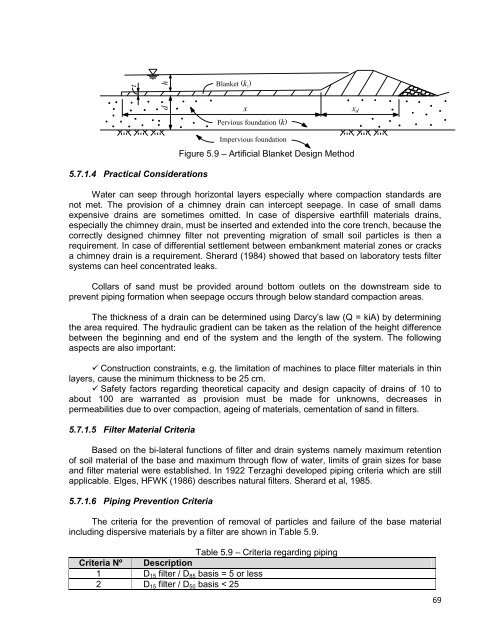SMALL DAMS PETITS BARRAGES
SMALL DAMS PETITS BARRAGES
SMALL DAMS PETITS BARRAGES
- TAGS
- dams
- petits
- barrages
- cbdb.org.br
Create successful ePaper yourself
Turn your PDF publications into a flip-book with our unique Google optimized e-Paper software.
t<br />
5.7.1.4 Practical Considerations<br />
h<br />
d<br />
Blanket (k 1)<br />
x xd<br />
Pervious foundation (k )<br />
Impervious foundation<br />
Figure 5.9 – Artificial Blanket Design Method<br />
Water can seep through horizontal layers especially where compaction standards are<br />
not met. The provision of a chimney drain can intercept seepage. In case of small dams<br />
expensive drains are sometimes omitted. In case of dispersive earthfill materials drains,<br />
especially the chimney drain, must be inserted and extended into the core trench, because the<br />
correctly designed chimney filter not preventing migration of small soil particles is then a<br />
requirement. In case of differential settlement between embankment material zones or cracks<br />
a chimney drain is a requirement. Sherard (1984) showed that based on laboratory tests filter<br />
systems can heel concentrated leaks.<br />
Collars of sand must be provided around bottom outlets on the downstream side to<br />
prevent piping formation when seepage occurs through below standard compaction areas.<br />
The thickness of a drain can be determined using Darcy’s law (Q = kiA) by determining<br />
the area required. The hydraulic gradient can be taken as the relation of the height difference<br />
between the beginning and end of the system and the length of the system. The following<br />
aspects are also important:<br />
� Construction constraints, e.g. the limitation of machines to place filter materials in thin<br />
layers, cause the minimum thickness to be 25 cm.<br />
� Safety factors regarding theoretical capacity and design capacity of drains of 10 to<br />
about 100 are warranted as provision must be made for unknowns, decreases in<br />
permeabilities due to over compaction, ageing of materials, cementation of sand in filters.<br />
5.7.1.5 Filter Material Criteria<br />
Based on the bi-lateral functions of filter and drain systems namely maximum retention<br />
of soil material of the base and maximum through flow of water, limits of grain sizes for base<br />
and filter material were established. In 1922 Terzaghi developed piping criteria which are still<br />
applicable. Elges, HFWK (1986) describes natural filters. Sherard et al, 1985.<br />
5.7.1.6 Piping Prevention Criteria<br />
The criteria for the prevention of removal of particles and failure of the base material<br />
including dispersive materials by a filter are shown in Table 5.9.<br />
Table 5.9 – Criteria regarding piping<br />
Criteria Nº Description<br />
1 D15 filter / D85 basis = 5 or less<br />
2 D15 filter / D50 basis < 25<br />
69














